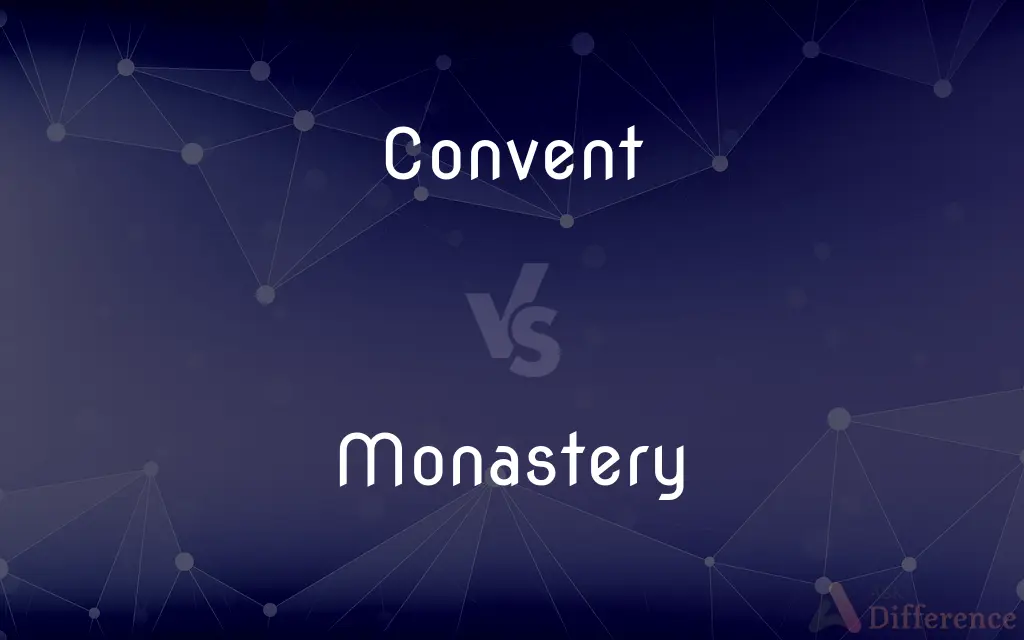Convent vs. Monastery — What's the Difference?
By Tayyaba Rehman & Maham Liaqat — Updated on April 5, 2024
A convent is a community of nuns; a monastery is home to monks. Both are places of religious retreat, but their residents differ.

Difference Between Convent and Monastery
Table of Contents
ADVERTISEMENT
Key Differences
Convents are primarily residences for nuns who have dedicated their lives to religious vows, focusing on community service and prayer. These institutions often engage in educational and humanitarian efforts, serving as schools, hospitals, or shelters. On the other hand, monasteries house monks who may lead more secluded lives, devoted to contemplation, study, and the preservation of religious texts and practices. While both convents and monasteries are centers of spiritual life, their approaches to community interaction and solitude vary.
While convents are often seen as open to the community, providing education and assistance, monasteries might prioritize a life of solitude and contemplation, sometimes engaging in specialized crafts or agriculture. This difference reflects the distinct spiritual paths and missions of nuns and monks.
Convents, under the guidance of an abbess or mother superior, emphasize communal living and shared responsibilities among the sisters. Monasteries, governed by an abbot or prior, might focus more on individual spiritual growth and self-sufficiency within the communal setting.
The architecture of convents and monasteries also reflects their different functions and lifestyles. Convents may feature more communal spaces for education and outreach, whereas monasteries might have extensive libraries and private cells for meditation.
Despite their differences, both convents and monasteries play crucial roles in preserving religious traditions, offering spiritual guidance, and serving their communities. Their unique contributions to spiritual life and society highlight the diverse expressions of monastic life.
ADVERTISEMENT
Comparison Chart
Residents
Nuns
Monks
Primary Focus
Community service and prayer
Contemplation and study
Leadership
Abbess or Mother Superior
Abbot or Prior
Community Interaction
Often involved in educational and humanitarian efforts
May prioritize solitude, but some engage in crafts or agriculture
Architecture
Designed for communal living and outreach
Includes private cells for meditation and extensive libraries
Compare with Definitions
Convent
Nuns in a convent live a life of poverty, chastity, and obedience, focusing on communal living.
Life in the convent is governed by a strict schedule of prayer and work.
Monastery
Monasteries are centers for spiritual retreat, contemplation, and preservation of religious practices.
He went on a retreat at the monastery to find peace and solitude.
Convent
A convent is a religious community or building where nuns live and work.
She visited the convent to learn more about the life of nuns.
Monastery
Monks in a monastery may lead a cloistered life, dedicating themselves to prayer, study, and manual labor.
Monks in the monastery rise before dawn for their first prayers.
Convent
Convents often serve as centers for education, healthcare, and other community services.
The local convent runs a school for underprivileged children.
Monastery
A monastery is a building or complex where monks live, work, and worship.
The ancient monastery is located atop a remote mountain.
Convent
An abbess or mother superior usually leads a convent.
The abbess of the convent was respected throughout the community.
Monastery
An abbot or prior typically governs a monastery.
The monastery’s abbot has written several books on meditation.
Convent
Convents often engage with the surrounding community, providing various forms of assistance.
The convent offers a soup kitchen for the homeless every weekend.
Monastery
Some monasteries produce goods like cheese or beer, contributing to their self-sufficiency and community engagement.
The monastery is famous for its handcrafted cheese sold at local markets.
Convent
A convent is a community of either priests, religious brothers, religious sisters, monks or nuns; or the building used by the community, particularly in the Catholic Church, Lutheran churches, and the Anglican Communion.
Monastery
A monastery is a building or complex of buildings comprising the domestic quarters and workplaces of monastics, monks or nuns, whether living in communities or alone (hermits). A monastery generally includes a place reserved for prayer which may be a chapel, church, or temple, and may also serve as an oratory, or in the case of communities anything from a single building housing only one senior and two or three junior monks or nuns, to vast complexes and estates housing tens or hundreds.
Convent
A Christian community of nuns living together under monastic vows
Maria entered the convent at the age of eighteen
Monastery
A community of persons, especially monks, bound by vows to a religious life and often living in partial or complete seclusion.
Convent
A community, especially of nuns, bound by vows to a religious life under a superior.
Monastery
The dwelling place of such a community.
Convent
The building or buildings occupied by such a community.
Monastery
A residence for monks or others who have taken religious vows.
Convent
A religious community whose members live under strict observation of religious rules and self-imposed vows.
Monastery
A house of religious retirement, or of secusion from ordinary temporal concerns, especially for monks; - more rarely applied to such a house for females.
Convent
The buildings and pertaining surroundings in which such a community lives.
Monastery
The residence of a religious community
Convent
Synonym of nunnery, a female religious community and its residence.
Convent
(India) A Christian school.
Convent
A gathering of people lasting several days for the purpose of discussing or working on topics previously selected.
Convent
A coming together; a meeting.
Convent
(obsolete) To call before a judge or judicature; to summon; to convene.
Convent
(obsolete) To meet together; to concur.
Convent
(obsolete) To be convenient; to serve.
Convent
A coming together; a meeting.
A usual ceremony at their [the witches] convents or meetings.
Convent
An association or community of recluses devoted to a religious life; a body of monks or nuns.
One of our convent, and his [the duke's] confessor.
Convent
A house occupied by a community of religious recluses; a monastery or nunnery.
One seldom finds in Italy a spot of ground more agreeable than ordinary that is not covered with a convent.
Convent
To meet together; to concur.
Convent
To be convenient; to serve.
When that is known and golden time convents.
Convent
To call before a judge or judicature; to summon; to convene.
Convent
A religious residence especially for nuns
Convent
A community of people in a religious order (especially nuns) living together
Common Curiosities
What is a monastery?
A monastery is a living space for monks focused on spiritual contemplation, study, and sometimes manual labor.
What is the leadership structure in a convent?
A convent is typically led by an abbess or mother superior who oversees its operations and spiritual life.
How do convents and monasteries differ in their community roles?
Convents often focus on community service and education, while monasteries might prioritize solitude and self-sufficiency, though many also engage in community support.
What is the main purpose of a convent?
The main purpose of a convent is to provide a space for nuns to live their religious vows and serve the community.
What is a convent?
A convent is a residence for nuns, dedicated to religious life, prayer, and serving the community.
Who lives in a convent?
Nuns, who have taken vows of poverty, chastity, and obedience, live in a convent.
Who resides in a monastery?
Monks, men who have dedicated their lives to religious observance and practices, reside in a monastery.
Can men visit convents?
Yes, men can visit convents, especially during public events, services, or by arrangement.
Can women join monasteries?
Women cannot join monasteries designed for monks, but they can join convents or female monastic communities.
What is the main purpose of a monastery?
The main purpose of a monastery is to offer monks a dedicated environment for spiritual growth, contemplation, and religious practice.
How are convents and monasteries funded?
They are often funded through donations, grants, and in some cases, by selling goods produced by the residents, like crafts or agricultural products.
What type of work do nuns in a convent do?
Nuns engage in various forms of work, including education, healthcare, and community service.
Do monks in monasteries interact with the outside world?
While some monks lead secluded lives, others may interact with the community, often through work, teaching, or producing goods.
Are convents and monasteries only Catholic institutions?
While commonly associated with the Catholic Church, convents and monasteries also exist in other Christian denominations and religions.
Can anyone visit a convent or monastery?
Many convents and monasteries welcome visitors, though some may have restrictions or require arrangements.
Share Your Discovery

Previous Comparison
Adversely vs. Conversely
Next Comparison
Uncooked vs. RawAuthor Spotlight
Written by
Tayyaba RehmanTayyaba Rehman is a distinguished writer, currently serving as a primary contributor to askdifference.com. As a researcher in semantics and etymology, Tayyaba's passion for the complexity of languages and their distinctions has found a perfect home on the platform. Tayyaba delves into the intricacies of language, distinguishing between commonly confused words and phrases, thereby providing clarity for readers worldwide.
Co-written by
Maham Liaqat















































